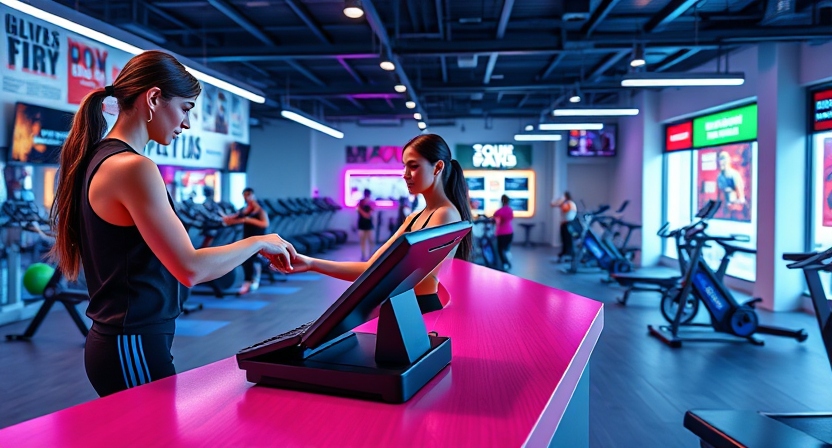
By Ellie Marsden January 8, 2025
A Point of Sale (POS) system is more than just a tool to process payments; it’s a crucial component of a fitness studio’s operation. The right POS system can help manage memberships, track attendance, handle scheduling, and even improve customer experience. With a variety of options on the market, selecting the ideal POS system for your fitness studio can be overwhelming. This guide will help you navigate the decision-making process by highlighting key factors and features to consider.
Understanding the Basics of a POS System
A POS system is a combination of hardware and software that allows businesses to manage sales transactions. For a fitness studio, it goes beyond merely accepting payments. The system can integrate with other tools to streamline business operations, such as:
1.Membership management – Automates sign-ups, renewals, and cancellations.
2.Class scheduling – Allows clients to book and cancel classes online.
3.Inventory tracking – Keeps track of merchandise like fitness apparel, supplements, or equipment.
4.Reporting and analytics – Provides insights into revenue, attendance, and customer behavior.
Understanding what a POS system does for a fitness studio is the first step in choosing one that meets your unique needs.
Key Features to Look for in a POS System
1. Payment Processing Flexibility
The primary function of any POS system is to handle payments efficiently. In a fitness studio, you may encounter various payment types, such as one-time drop-in fees, monthly memberships, class packages, and retail purchases. Therefore, your POS system should support:
- Multiple payment methods – Including credit/debit cards, digital wallets (Apple Pay, Google Pay), and direct bank transfers.
- Recurring billing – Automates membership renewals to save time and reduce errors.
- Split payments – Allows clients to pay with multiple methods if needed.
Ensuring that your POS system has flexible payment options can enhance the customer experience and simplify financial management.
2. Membership Management Capabilities
Efficient membership management is essential for any fitness studio. A good POS system should offer features that make it easy to:
- Sign up new members – Both in-studio and online.
- Track member attendance – Helps in understanding customer engagement and retention.
- Offer tiered memberships – Supports different membership levels with varying privileges.
- Manage promotions and discounts – Enables promotional campaigns to attract and retain clients.
By automating these processes, you can focus more on delivering high-quality services rather than administrative tasks.
3. Scheduling and Booking Integration
A POS system with built-in scheduling tools is invaluable for fitness studios that offer group classes or personal training sessions. Look for systems that allow:
- Online booking – Clients can view available classes and book slots at their convenience.
- Automated reminders – Sends notifications to clients about upcoming classes, reducing no-shows.
- Capacity management – Ensures that classes don’t get overbooked by tracking available slots.
Integrating scheduling and booking into your POS system improves operational efficiency and provides a better customer experience.
Hardware Considerations
1. User-Friendly Interface
The hardware components of a POS system include the terminal, receipt printer, barcode scanner, and card reader. It’s important to choose hardware with a user-friendly interface, as this will reduce the learning curve for your staff and minimize errors during transactions.
2. Mobility
Many fitness studios operate across multiple locations or have pop-up events. A mobile POS system that works on tablets or smartphones offers the flexibility to handle transactions anywhere. Look for systems with cloud-based access so that data syncs in real-time across all devices.
3. Durability
Fitness studios are active environments where equipment can get knocked around. Ensure that your POS hardware is robust and built to withstand daily wear and tear.
Software and Integration Options
1. Integration with Existing Tools
Most fitness studios use a variety of software for different operations. A good POS system should integrate seamlessly with:
- Accounting software – For streamlined financial reporting.
- Marketing tools – To run promotional campaigns and email newsletters.
- Customer Relationship Management (CRM) systems – To maintain detailed client profiles.
- Fitness apps – Some studios have branded apps that clients use to book classes or track progress.
The ability to integrate with existing tools ensures that your POS system becomes a central hub for all studio operations.
2. Cloud-Based vs. On-Premise Systems
POS systems can be cloud-based or on-premise. Cloud-based systems store data online, allowing for remote access and automatic updates. They tend to be more flexible and scalable. On-premise systems store data locally, offering more control but requiring manual updates and backups.
For most fitness studios, a cloud-based POS system is preferable due to its convenience and lower maintenance requirements.
Cost Considerations
1. Initial Setup Costs
When evaluating different POS systems, consider the initial setup costs, which may include:
- Hardware purchase – Terminals, card readers, printers.
- Installation fees – Some providers charge for setting up the system.
- Software licensing – Depending on whether the software is subscription-based or a one-time purchase.
2. Ongoing Costs
In addition to the initial setup costs, you should account for ongoing expenses, such as:
- Subscription fees – Cloud-based systems typically charge monthly or annual fees.
- Transaction fees – Payment processing fees vary by provider.
- Maintenance and support – Some providers offer tiered support plans.
Comparing the total cost of ownership will help you choose a POS system that fits your budget without sacrificing essential features.
Security and Compliance
1. Data Security
With a high volume of financial transactions and sensitive customer information, data security is paramount. Ensure that your POS system offers:
- Encryption – Protects data during transmission.
- Tokenization – Replaces sensitive data with non-sensitive tokens.
- PCI compliance – Meets industry standards for payment processing.
2. User Permissions
A good POS system allows you to set different levels of access for staff members. For example, front-desk staff may only need access to booking and payment features, while managers require access to reports and analytics.
Customer Support and Training
1. Availability of Support
Even the best POS systems can encounter issues. Reliable customer support ensures that problems are resolved quickly, minimizing downtime. Look for providers that offer:
- 24/7 support – Especially if your studio operates early mornings or late evenings.
- Multiple support channels – Including phone, email, and live chat.
2. Staff Training
Introducing a new POS system requires staff training. Many providers offer online tutorials, webinars, or on-site training. Ensuring your staff is comfortable using the system will result in smoother operations and a better customer experience.
Scalability and Future-Proofing
1. Scalability
As your fitness studio grows, your POS system should be able to scale with it. This includes:
- Adding new locations – Seamless management of multiple branches.
- Increasing member capacity – Handling a growing client base without performance issues.
- Expanding service offerings – Supporting new services such as online classes or merchandise sales.
2. Future-Proofing
Technology evolves rapidly, so it’s important to choose a POS system that stays up-to-date with industry trends. Look for providers that offer regular software updates and are committed to innovation.
Conclusion
Choosing the right POS system for your fitness studio is a critical decision that can impact your operational efficiency and customer satisfaction. By considering factors such as payment flexibility, membership management, integration capabilities, and scalability, you can select a system that meets your current needs while preparing for future growth.
Investing time in evaluating different options will pay off in the long run, ensuring that your fitness studio runs smoothly and delivers a top-notch experience to your clients. Whether you’re a small boutique gym or a large multi-location chain, the right POS system can be a game-changer for your business.
